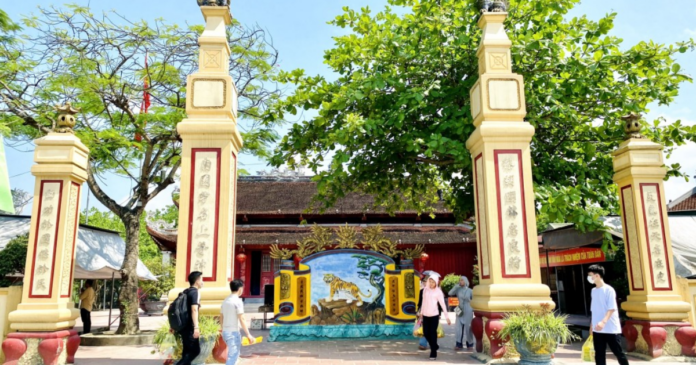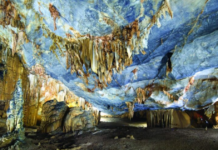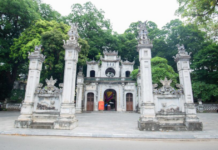The Ong Hoang Muoi Temple is one of the most sacred and famous temples in central Vietnam. It attracts visitors not only for its spiritual significance but also for its unique architecture and picturesque natural surroundings. With its rich legends and distinct cultural features, the Ong Hoang Muoi Temple is an ideal destination for those seeking to learn about folk beliefs and traditional cultural values. In this article, we will explore the historical and spiritual significance of this temple.
1.Location and Directions to Ong Hoang Muoi Temple
1.1. Location of the Temple
The Ong Hoang Muoi Temple, also known as the Mo Hac Temple or Xuan Am Temple, is not only a prominent cultural monument but also an ideal spiritual destination for those seeking peace and good fortune. Located in Hung Nguyen District, Nghe An Province, the temple was built in the 17th century to honor Ong Hoang Muoi, a figure who played a significant role in helping the people settle and prosper. With over 400 years of history, the Ong Hoang Muoi Temple preserves cultural values and spiritual respect for the national intangible cultural heritage. Every year, the temple attracts thousands of visitors, especially during major festivals such as the opening ceremony on the 15th day of the 3rd lunar month and the Ong Hoang Muoi death anniversary on the 10th day of the 10th lunar month. Throughout the months of September and October in the lunar calendar, the place is always bustling with people coming to pray, perform rituals, and visit.

1.2. Directions to the Temple
To reach the Ong Hoang Muoi Temple, you can start your journey from Hanoi. For a comfortable exploration of the temple, it is recommended to plan a trip lasting two or three days. The most flexible option is to travel by private vehicle. You can choose one of two routes:
- Pháp Vân Expressway – National Route 1A: From Hanoi, take the Phap Van Expressway and then turn onto National Route 1A. This 5-hour journey will bring you to the beautiful region of Nghe An.
- Thăng Long Avenue – Ho Chi Minh Trail: Another option is to follow Thang Long Avenue and then continue along the Ho Chi Minh Trail. This route is not only shorter but also offers breathtaking natural landscapes.
>> Phung Khoang Market: The Ultimate Guide to Dining and Shopping “Unmissable” Experiences
2. Learn about the History and Culture of the Temple
2.1. Longstanding History
The Ong Hoang Muoi Temple was built in 1634 during the Later Le Dynasty, and it is one of the prominent spiritual and cultural symbols in Nghe An. Over the centuries, the temple has witnessed many ups and downs, including damage caused by natural disasters and wars, but its spirit and significance have remained intact in the hearts of the people. After a long period of destruction, the Ong Hoang Muoi Temple was restored and rebuilt in 1995 with traditional architecture. The current temple includes various sections such as the main gate, side gates, central platform, and the towers for the male and female spirits, creating a sacred and solemn space. With three main halls – the Upper Hall, the Middle Hall, and the Lower Hall – the architecture clearly reflects the Nguyen Dynasty style. The temple features intricate wooden carvings, rich in national cultural symbols, such as dragon, lion, turtle, and phoenix motifs.
In 2002, thanks to the efforts of the local government and community in preserving and developing it, the Ong Hoang Muoi Temple was recognized as a special historical and cultural heritage site in Nghe An Province. Every year, two major festivals – the 15th day of the 3rd lunar month and the 10th day of the 10th lunar month – attract thousands of visitors from all over to participate. These festivals not only provide an opportunity for people to pray for peace and good fortune but also serve as a chance to explore the distinctive culture and traditions of Nghe An.
>> Khai Nguyen Pagoda in Hanoi: A Prominent Spiritual Destination with Unique Architecture
2.2. The Legend of Ong Hoang Muoi
Ong Hoang Muoi is a legendary figure closely associated with the history and culture of Nghe An. He is revered as a divine being with a noble mission: to help the people overcome the hardships of life. According to legend, he is the tenth son of the Heavenly King Bat Hai Đong Đinh, sent down to Earth to protect the borders and stabilize the lives of the people during difficult times. The name “Hoang Muoi” not only signifies his position as the tenth son but also symbolizes the completeness and perfection of a god with comprehensive talents.
In folk stories, Ong Hoang Muoi is also known by the title Uy Minh Vuong Ly Nhat Quang, the son of King Ly Thai To. In this role, he made significant contributions to the royal court and to the land of Nghe An, expanding the borders and developing the local economy and culture. Some people believe that he is the general Le Khoi, who played a key role in the resistance against the Ming invaders, helping to restore national independence.

According to another famous legend, Ong Hoang Muoi is identified with General Nguyen Xi, a heroic figure who sacrificed his life in a battle on the river near Hong Linh Mountain. His sacrifice left a deep sense of sorrow in the hearts of the local people, leading to the establishment of a small temple in memory of the talented general. Today, Ong Hoang Muoi remains a symbol of prosperity, reflecting the patriotic spirit and gratitude of the people towards those who devoted their lives to the country.
2.3. Cultural Value of the Temple
The Ong Hoang Muoi Temple is not only a place of worship but also a unique cultural heritage site with profound spiritual significance for the people of Nghe An and visitors. With a history dating back to 1634, the temple has become a repository of many traditional cultural values, reflecting respect and gratitude towards a legendary figure associated with the protection of the country.
The architecture of the temple clearly reflects the construction style of the Nguyen Dynasty, particularly the exquisite carvings that demonstrate the talent and skill of Vietnamese artisans. The temple’s spacious grounds are surrounded by majestic natural landscapes, creating a peaceful and serene atmosphere for visitors. Additionally, the temple preserves numerous royal edicts and sacred inscriptions in Chinese characters, along with a collection of statues with high aesthetic value, further enriching the intangible cultural heritage of the nation.

Every year, the Ong Hoang Muoi Temple hosts several important festivals, such as the opening ceremony on the 15th day of the 3rd lunar month and the death anniversary on the 10th day of the 10th lunar month. These festivals attract large numbers of local people and tourists. These events not only express community spirit and the connection between generations but also contribute to the preservation and promotion of traditional cultural values, helping the younger generation understand and appreciate the cultural heritage passed down by their ancestors. Therefore, the Ong Hoang Muoi Temple has become a symbol of patriotism, cultural pride, and a place where the spiritual and cultural realms of the Vietnamese people converge.
3. Who is the Temple Dedicated To?
The Ông Hoàng Mười Temple in Nghệ An is not merely a site for worshiping a single deity; it is also a place that honors many sacred figures and deities of prosperity. In addition to honoring Ông Hoàng Mười (Quan Hoàng Mười), the temple also venerates other figures such as the Holy Mother Liễu Hạnh, the Mother of Four Realms (Mẫu Tứ Phủ), the Twin Goddesses Ngọc Nữ, as well as historical figures like General Lê Khôi and Duke Trịnh Trung. The worship of these multiple deities creates a rich and multi-dimensional spiritual atmosphere, attracting large numbers of pilgrims and visitors from all over.

There are many legends and versions regarding the origin and identity of Ong Hoang Muoi. In one prominent version, he is considered to be Le Khoi, a talented general who made significant contributions during the resistance against the Ming invaders. After his death, he was venerated and became a protective deity for the people, symbolizing the gratitude of the people for his contributions to the defense of the homeland. As a result, the Ong Hoang Muoi Temple was built to honor and commemorate him.
4. Highlights of the Ong Hoang Muoi Temple
The Ong Hoang Muoi Temple is not only notable for its historical significance but also attracts visitors due to its unique architecture and traditional festivals. The temple’s architecture reflects traditional Vietnamese styles, with three main halls made of wood and adorned with intricate carvings. The spacious grounds, covering approximately 1 hectare, provide visitors with the opportunity to explore and admire the sacred beauty of the temple. Additionally, the festivals held at the temple are important events that draw large numbers of locals and tourists alike.
4.1 Unique Folk Architecture
The Ong Hoang Muoi Temple in Nghe An is not only a sacred place of worship but also an architectural masterpiece that carries the strong imprint of Vietnamese folk culture. Situated on a site of about 1 hectare, the temple is surrounded by beautiful natural scenery, creating a peaceful and mystical atmosphere.
The temple’s architecture is designed in the traditional Vietnamese style, with exquisite carvings on precious wood materials. Every detail showcases the craftsmanship of the artisans, from the dragon, lion, turtle, and phoenix motifs to the symbolic images of spirituality. The main gate leading to the temple is built in the form of a triple gate (tam quan), creating a clear separation between the outer world and the sacred space within. The temple’s layout includes the Upper Hall, the Middle Hall, and the Lower Hall, arranged harmoniously to reflect a sense of reverence and respect.
4.2. Festivals at the Ong Hoang Muoi Temple
The Ong Hoang Muoi Temple is one of the most attractive spiritual destinations in Nghe An. It not only draws visitors with its unique architecture but also with its rich and meaningful festivals. These festivals not only express respect for Ong Hoang Muoi but also offer an opportunity for locals and tourists to immerse themselves in the distinctive cultural atmosphere of the Nghệ An region.
The Procession of Royal Edicts Festival
One of the largest festivals at the temple is the Procession of Royal Edicts Festival, which takes place on the 14th, 15th, and 16th days of the 3rd lunar month. The festival begins with the Yet Cao Ceremony in the morning, followed by the Royal Edicts Procession from the Nguyen family’s ancestral temple to the Ong Hoang Muoi Temple in the afternoon, and ends with the Thanksgiving Ceremony in the evening of the same day. The festival features not only solemn rituals but also various traditional folk games, providing a platform for young people to showcase their talents and giving visitors a chance to discover the unique local specialties of Nghe An.

The Death Anniversary of Ong Hoang Muoi
It is impossible not to mention the Death Anniversary of Ong Hoang Muoi, which takes place on the 10th day of the 10th lunar month. This is the largest festival of the year to honor the contributions of the official who made significant efforts for the country and its people. The anniversary lasts for three days, including both the ceremonial and festive parts, organized in a grand manner according to traditional rituals. In the morning, the ceremonies are conducted solemnly. In the afternoon and evening, it is time for the festive activities, ranging from cultural performances to fascinating folk games that attract many visitors.
Attractive Festival Activities
In addition to the two main festivals, the Ong Hoang Muoi Temple also organizes many other exciting events. Every year, the festivals here attract hundreds of thousands of visitors, not only to explore the Mother worship beliefs but also to experience the unique cultural features of the region. One of the prominent activities during the festival is the lantern release ceremony on the evening of the 9th lunar day, right before the temple gate, on the Con Moc River. This event not only creates a vibrant scene but also provides an opportunity for people to pray for luck and peace for their families and loved ones.
The festivals at the Ong Hoang Muoi Temple are not just about worship; they also serve as a chance to preserve and promote the intangible cultural values recognized by UNESCO. Come to the Ong Hoang Muoi Temple to immerse yourself in the lively festival atmosphere and discover the mysterious stories of this land!
5. Common Questions and Tips When Visiting Ong Hoang Muoi Temple
When visiting the Ong Hoang Muoi Temple in Nghe An, many visitors often have questions and seek useful information to ensure the best experience. Below are some important tips and frequently asked questions you should know before embarking on your journey to explore this sacred temple.
Frequently Asked Questions:
When is the festival held?
The Ong Hoang Muoi Temple organizes two major annual festivals: the Opening Festival on the 15th of the 3rd lunar month and the Death Anniversary of Ong Hoang Muoi on the 10th of the 10th lunar month. During these days, the festival atmosphere is vibrant, with numerous cultural and spiritual activities.
Can I visit the temple at any time?
Although the main festivals occur on specific dates, you can visit the temple anytime throughout the year to pray and offer incense. However, during full moon and the 1st day of each lunar month, the temple also attracts many local people and tourists.

Which day is best to avoid crowds?
For a more peaceful and complete experience without the crowds, you should choose days that are not during festival periods or public holidays.
This allows you to better appreciate the sacred atmosphere of the temple:






